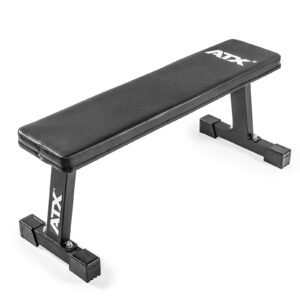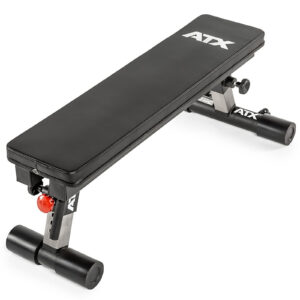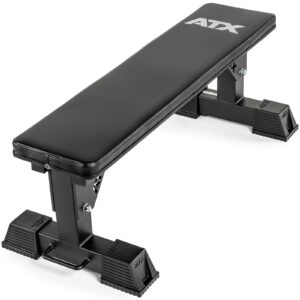
Flat Bench Press Gym Benches
Our flat gym benches offer you remarkable stability and performance even under heavy loads. Perfect for intense bench press sets. On top of their heavy-duty construction, our functional benches also offer versatility with adjustable positions from incline to decline.
- Superior durability & strength
- Flexible & functional
- Safety mechanisms
- Commercial upholstery
- User-friendly design
-
This item is in stock!

ATX® Flat Bench Compact
SKU: ATX-FBX-510$340.00 Add to cart -
This item is in stock!

ATX® Flat Bench PRO
SKU: ATX-FBX-610$440.00 Add to cart -
This item is in stock!

ATX® Commercial Flat Bench
SKU: ATX-FBX-630$395.00 Add to cart -
This item is in stock!

ATX® Flat Bench
SKU: ATX-FBX-800$495.00 Add to cart
Showing all 4 results
Flat Gym BenchesFrequently Asked Questions
What does Flat Bench Press Target?
Flat Bench Press is a compound or a multi-joint movement. During this exercise, you will recruit many different muscle groups.
The main ones being Chest (pectoral muscles), Triceps, Shoulders (Front and Medial Deltoids) plus the stabilizers: Rotator Cuff Muscles, Scapular Stabilizers (Trapezius, Serratus Anterior and Rhomboids), Core Muscles (Abdominals and Obliques) and Biceps.
There are five different flat bench press variations you could perform to target different muscle heads/groups.
1. Competition Grip or Wide Bench Press – will place the most load on your pecs and will allow you to press the most weight. Mostly because of the reduced range of motion.
2. Middle Grip Bench Press – a great balanced press which uses more triceps compared to competition grip bench press while still utilizing a great deal of chest muscles.
3. Narrow or Close Grip Bench Press – will place the most load on your triceps and will be the most difficult to complete. Simply because you won’t get as much pec activation during this movement.
4. Neutral Grip Bench Press – performed with a Swiss/Multi Grip Bar. This movement is a tad easier on your shoulders and wrists. It places more strain on your triceps.
5. Reverse Grip Bench Press – provides an increase in upper chest activation as well as places more load on your biceps.
Obviously, there are far more variations you could perform on a flat bench such as Larsen Press. This is a bench press without a leg drive. But it should be performed by advanced lifters as it primarily performed to improved stability and oblique control.
Do not ever use a thumbless/suicide grip as the alleviated wrist strain is not worth risking being crushed by a barbell.
How High is a Flat Bench?
Most flat benches will be 44 to 45cm in height. This is due to the International Powerlifting Federation’s (IPF) bench height specifications. Bench presses for competition must be 44 to 45cm in height.
This height became the standard as it is optimal height for bench pressing – for most body shapes and sizes. There are flat benches that are higher and lower. If you are choosing a flat bench for your home gym and you want to it to feel like the one you use in the gym, then a 44-45cm bench is the way to go.
Can a Flat Bench alone build a Good Chest?
The principles of muscle building when it comes to training are the same for any muscle group. If you want to grow you will have to do a variety of exercises. Reason behind that is that our muscles become efficient at any exercise we perform for a prolonged period.
If you just stick to flat bench press alone, you will be able to build up the chest muscle. However eventually the progress will slow down and so will your growth. To continue building the chest muscles and avoid muscle imbalances, you should include accessory exercises into your training such as incline press, pec fly’s, dips or even push ups.
What Exercises can I do on a Flat Bench?
There are so many exercises that you can do on a flat bench. A quality adjustable bench can be expensive these days. They are excellent and offer loads of exercises, but I would recommend buying a quality flat bench over a cheap adjustable bench. A broken adjustable bench offers no exercises!
Here are just some of the exercises you can do on a flat bench:
1. Flat bench press – you can do it with dumbbells. Or if you have a power rack or squat rack you can do them with a barbell too.
2. Dumbbell Flyes
3. Dumbbell Pullover – this is an old school bodybuilding exercise that hits both chest and back.
4. Triceps dips – Sit on the middle of the bench facing to one side. Put your palms next to you and press up, then out. Now you can do dips!
5. Skull Crushers – with dumbbells or EZ curl barbell.
6. Seated shoulder press – I prefer doing this exercise on a flat bench, without back support. You lift a lot less weight. But I feel my shoulders working more. Great for your core as well.
7. Seated Bicep Curls
8. Leg Raises.
There are many other variations that you can do too. As you can see there is loads of variety in terms of body parts that you can target on a flat bench.
What Muscles does a Bench Press work?
Bench Press is a compound exercise meaning that it is a multi-joint movement during which you are working multiple muscle groups. The main muscle groups worked are your chest muscles, triceps, and front deltoids. The closer your grip the more strain you will place on your triceps, the wider the grip the more load will be taken up by your chest muscles.
What is a Good Bench Press?
Are we talking about the equipment or lift? We will address both.
Beginner and intermediate lifters should aim at benching their bodyweight. For example, if you weigh 80 kgs and you can press 80 kgs for a single rep, that would be considered a good bench press. Advanced lifters should be aiming at a bench press 1.5 x their bodyweight. If you can press twice your body weight you are an elite level lifter.
A good bench press for your gym will be both solid and safe. Solid in terms of the construction and materials used. Safety refers to spotter arms of similar mechanism that will protect you if you fail the rep when training alone.
Another aspect is adjustability. Your start and stop position will vary to other lifters. Being able to change the start/stop position is important.
Is it Safe to Bench Press alone?
It is safe to bench press alone, but you must make sure that you use spotters when lifting. They are there to prevent the bar from falling on you in case you fail a rep. Therefore, if you plan on training alone then it is critical that you choose a bench press, power cage or squat rack that has spotters. Make sure it is of a decent quality and standard too.
The spotters must also be setup correctly for them to do their job. Ensure they are set at a height just below your chest. Just make sure you do a few warmup reps to make sure they are adjusted in the correct position.
What is the Height of a Bench Press?
The standard height of the bench used in Powerlifting competitions is 44-45cm. Anything higher than that and you might have trouble bracing yourself during the lifts as it will be difficult to keep your feet down. If you plan on entering powerlifting competitions, then strongly recommend that you get a bench that 44 or 45cm high.

